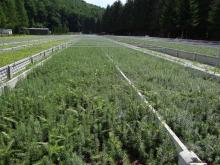 Asset Publisher
Asset Publisher
Polish forests
Poland is in the European lead, while concerning the area of all forests. They cover about 29,2 % of the country territory, and grow within the area of 9,1 million hectares. The overwhelming majority of the forests is state owned, of which almost 7,6 million hectares are managed by the State Forests National Forest Holding..
The number of Polish forest is still growing. The forestation rate of the country has increased from 21 % in 1945 to 29,2 % at the moment. Between 1995 and 2008, the forest area increased by 310 thousand ha. The basis for afforestation works is the "National Programme for Increasing the Forest Cover" (KPZL), assuming an increase of the forestation rate up to 30 % by 2020 and up to 33 % by 2050. Polish forests abound in flora, fauna and fungi. 65 % of the total number of animal species live there.
The forests grow in our country on poor soils, mainly because of the development of the agriculture in previous years. It influences the distribution of the types of the forest sites in Poland. Over 55 % of the forest areas is covered with coniferous forests. In other areas, there are forest sites, mainly the mixed ones. Their small part constitute alder and riparian forests – not more than 3 %.
In the years 1945 – 2011 the area of natural deciduous tree stands within the area of the State Forests National Forest Holding increased from 13 to 28,2 %.
Within the lowlands and uplands the most often occurring tee species is pine. It covers 64,3 % of the forest area of the State Forests National Forest Holding and 57,7 % of private and commune forests. In the mountains the predominant species is European spruce ( in the west) and European spruce with beech (in the east). Domination of pine is the result of carrying on sustainable forest management in the past. Once, the monocultures (crops or cultivations of one species) were the answer to the great demand of industry for wood. Such forests appeared to be quite fragile to climatic factors. They also were often the prey of pests' expansion.
In Polish forests, the share of other tree species, especially deciduous trees have been systematically increasing. The foresters have stepped aside from monocultures – that is why, they try to fit specific species of the forest stand to the natural stand, that would be proper for the given area. Thanks to that, in the years 1945 – 2011, the area of the deciduous tree stands within the lands of the State Forests National Forest Holding increased from 13 to 28,2 %. There occur more and more frequently the following tree species: oaks, ashes, maples, sycamore maples, elms, but also birches, beeches, alders, poplars, hornbeams, aspens, tilias and willows.
Our forests are the most often represented by the forest stands aged 40 to 80 years. The average age of the forest equals 60 years. More and more trees are of big size at the age over 80 years. Since the end of the Second World War, the forests' area has increased up to almost 1,85 million hectares.
Raport o stanie lasów w Polsce 2012
 Asset Publisher
Asset Publisher
Stanowisko RDLP w Krośnie w sprawie Inicjatywy Dzikie Karpaty
Stanowisko RDLP w Krośnie w sprawie Inicjatywy Dzikie Karpaty
Stanowisko Regionalnej Dyrekcji Lasów Państwowych w Krośnie wobec wniosku Inicjatywy Dzikie Karpaty w sprawie zaniechania prac hodowlanych w Nadleśnictwie Stuposiany
W piątek 22 listopada działacze IDK złożyli na ręce Dyrektora RDLP w Krośnie wniosek o całkowite zaniechanie prac hodowlanych w drzewostanach gospodarczych starszych klas wieku, zaś w ostatnich dniach pojawiły się żądania zaniechania prac w oddz. 219a Nadleśnictwa Stuposiany (leśnictwo Muczne), przewidzianych na rok 2020. Informuję, że podjęłam kroki w celu modyfikacji działań wynikających z planu urządzenia lasu w ramach gospodarstwa specjalnego w zlewni potoku Roztoki. Konkretne propozycje przedstawimy po wizji terenowej i przygotowaniu koncepcji aktywnej ochrony tego terenu z uwagi na walory przyrodnicze, przy jednoczesnym wyeksponowaniu wartości kulturowych obszaru.
Jeśli chodzi o drzewostan w oddz. 219a informuję, że rzeczywiście od kilku dziesięcioleci nie był on użytkowany, ale bieżący plan urządzenia lasu przewiduje w nim cięcia inicjujące odnowienia naturalne tzw. rębnią IVd, pozwalającą na elastyczne podejście hodowlane, stosowne do obecnego stanu lasu. Plan urządzenia zakłada w tym wydzieleniu pozyskanie na poziomie 181,5 metra sześciennego z hektara przy zasobności 605 metrów na hektar. Szacunki brakarskie wykonane w terenie wykazały potrzebę cięć na poziomie 133,8 metrów z hektara, zatem o prawie 50 metrów mniej. Na całej powierzchni daje to masę 4282 metry, przy założonej przez pul 5840 metrów. Nadmieniam, że łączną zasobność całego drzewostanu wyliczono na 19 500 metrów. Te liczby pokazują bardzo ostrożne podejście Nadleśnictwa do cięć, które mają na celu inicjowanie odnowienia naturalnego. Trzeba bowiem zwrócić uwagę na fakt, że brak w tym drzewostanie przyszłościowego młodego pokolenia drzew, przy bardzo wysokim średnim ich wieku sięgającym 100 lat.
Od wielu lat nie pojawia się w tym drzewostanie naturalne odnowienie w istotnej ilości, nawet w latach urodzaju nasion. Powodem tego jest m.in. brak dostatecznego dostępu młodych siewek do światła, bowiem w wydzieleniu dominują stare, duże drzewa o rozbudowanych koronach. Praktyka i nauka dowodzi, że bez ingerencji człowieka, poprawiającej warunki dla samosiewu, dojdziemy do etapu, kiedy młodszych drzew nadal nie będzie, a stary drzewostan zacznie naturalnie zamierać. Podkreślam, że nie ma tu mowy o zrębach zupełnych, cięcia będą wybiórcze, zgodnie z zasadami obowiązującymi nas w lasach górskich.
Zaznaczam, że po cięciach pozostaną zarówno drzewa spełniające funkcje ekologiczne (dziuplaste i będące siedliskami dla ksylobiontów), jak też najlepszej jakości okazy dające nadzieję na dobry obsiew i trwałość wszystkich elementów drzewostanu w przyszłości.
Rezygnacja z prac, jak życzą sobie działacze IDK, byłaby ze strony Nadleśnictwa zachowaniem niezgodnym z prawem i jednocześnie nieodpowiedzianym, bowiem skutkującym pogorszeniem stanu zasobów leśnych.
Grażyna Zagrobelna
Dyrektor RDLP w Krośnie


 fot. Paweł Fabijański
fot. Paweł Fabijański
 fot. Paweł Fabijański
fot. Paweł Fabijański
 fot. Paweł Fabijański
fot. Paweł Fabijański




